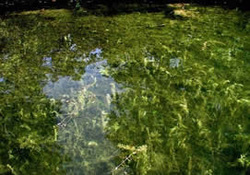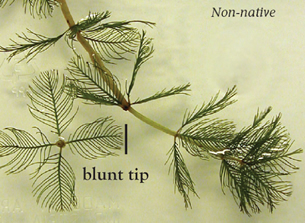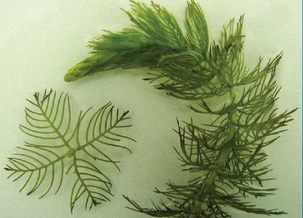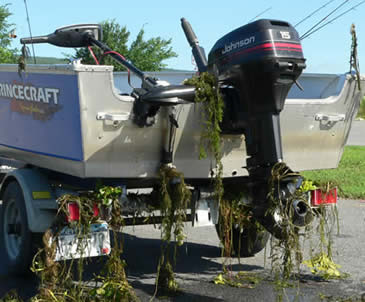FAQ's About Eurasion Water Milfoil

Photo courtesy of: Leslie J. Mehrhoff,
University of Connecticut, Bugwood.org
University of Connecticut, Bugwood.org
Why is it a problem?
Eurasian watermilfoil (EWM) is one of the most destructive and aggressive aquatic plants known. It grows rapidly—about one foot per week—and can form extremely dense mats that make recreational use almost impossible. EWM also spreads easily. Once established EWM crowds out native plants, diminishes fish habitat and negatively impacts wetland habitats. Dense mats form near the surface that entangle boat propellers and interfere with swimming and fishing. It also provides choice mosquito larvae habitat. As a result, Eurasian watermilfoil can adversely affect our enjoyment and use of the lake and impact property values. It is especially a problem in shallow lakes as it can grow up to 30 feet tall.
What does Eurasian watermilfoil look like?
Eurasian watermilfoil resembles the native Northern Watermilfoil (Myriophyllum sibiricum), however there are several distinguishing characteristics that can be used to differentiate between the two species. Unlike the Eurasian variety, Northern milfoil offers shade, shelter and foraging opportunities for fish. Click here for a Milfoil Look-a-Likes fact sheet - that includes additional look-a-like species.
Eurasian watermilfoil (EWM) is one of the most destructive and aggressive aquatic plants known. It grows rapidly—about one foot per week—and can form extremely dense mats that make recreational use almost impossible. EWM also spreads easily. Once established EWM crowds out native plants, diminishes fish habitat and negatively impacts wetland habitats. Dense mats form near the surface that entangle boat propellers and interfere with swimming and fishing. It also provides choice mosquito larvae habitat. As a result, Eurasian watermilfoil can adversely affect our enjoyment and use of the lake and impact property values. It is especially a problem in shallow lakes as it can grow up to 30 feet tall.
What does Eurasian watermilfoil look like?
Eurasian watermilfoil resembles the native Northern Watermilfoil (Myriophyllum sibiricum), however there are several distinguishing characteristics that can be used to differentiate between the two species. Unlike the Eurasian variety, Northern milfoil offers shade, shelter and foraging opportunities for fish. Click here for a Milfoil Look-a-Likes fact sheet - that includes additional look-a-like species.
Eurasian Watermilfoil
|
Native Northern Watermilfoil (Native - GOOD)
|
What should you do if you find Eurasian Watermilfoil in Jose Lake?
Leave it alone. As a homeowner you can carefully remove plants immediately around the area of your dock. (Read tips on Hand Harvesting - pdf) You need to know what you are doing because if you break the plant up you will just create more plants and do more harm than good. Eurasian Watermilfoil reproduces through vegetative propagation, so each tiny bit that floats off can form a new plant. If you find an area of Eurasian watermilfoil, email the JLIA with the location, approximate size (feet x feet) and water depth. You should check the Jose Lake EWM map - pdf to see if the JLIA already knows about the bed before reporting the cluster.
Where is it located in Jose Lake?
The Jose Lake EWM map - pdf shows the current known locations that have been identified. The main location is near the boat ramp which also provides a strong clue as to how it arrived in Jose Lake. Currently significant clusters have only been confirmed in a few locations but with the summer boat traffic cutting up the EWM it is likely to spread by the end of the summer. The current locations while small would be described as moderately dense.
Leave it alone. As a homeowner you can carefully remove plants immediately around the area of your dock. (Read tips on Hand Harvesting - pdf) You need to know what you are doing because if you break the plant up you will just create more plants and do more harm than good. Eurasian Watermilfoil reproduces through vegetative propagation, so each tiny bit that floats off can form a new plant. If you find an area of Eurasian watermilfoil, email the JLIA with the location, approximate size (feet x feet) and water depth. You should check the Jose Lake EWM map - pdf to see if the JLIA already knows about the bed before reporting the cluster.
Where is it located in Jose Lake?
The Jose Lake EWM map - pdf shows the current known locations that have been identified. The main location is near the boat ramp which also provides a strong clue as to how it arrived in Jose Lake. Currently significant clusters have only been confirmed in a few locations but with the summer boat traffic cutting up the EWM it is likely to spread by the end of the summer. The current locations while small would be described as moderately dense.
How does Eurasian watermilfoil spread?
The primary way Eurasian watermilfoil spreads is through vegetative reproduction. This spread is mainly through fragmentation of plant tips or through root expansion. With fragmentation, even a very small piece of this aquatic plant can float away, re-root and begin a new colony. It is easily fragmented and moved around within lakes by boats, or between lakes on boats and trailers. Eurasian watermilfoil can form thick, floating mats of vegetation, clogging the water and hindering recreation. It can grow in water 0.5 -10 meters deep.
Are there a lot of other weeds in the lake? Why aren’t these a problem?
Yes, there a many native species of plants and animals in the lake. Native species don’t overpopulate as they are typically held in check and controlled by predators, parasites, pathogens, or competitors maintaining a balance that has existed for hundreds or thousands of years. Invasive species like EWM (or animals such as Zebra mussles) do not have these natural checks as they are left behind when they are transported to a new environment. This gives invasive plants and animals an advantage over native species and makes them very difficult to control so they spread rapidly.
Once we have EWM in the lake is it too late to do anything?
No, we can reduce the spread and growth and manage the existing sites using herbicides, light blocking mats, hand harvesting and mechanical harvesting. The most important action is to start now before it is established in multiple areas and gets even more difficult and expensive to control. With active management approaches some lakes have been able to greatly reduce EWM and almost eliminate the species but it requires diligence and stopping new invasions by educating boaters about how to avoid re-introducing it into the lake.
What are Aquatic Nuisance Species (ANS) or Aquatic Invasive Species (AIS)?
“A species that is: 1.) non-native (or alien) to the ecosystem under consideration and 2.) whose introduction causes or is likely to cause economic or environmental harm or harm to human health.” As defined by the “Invasive Species Act” signed in 1999
What can be done to control Eurasian watermilfoil or other invasive aquatic plants?
Milfoil can be controlled using aquatically approved herbicides or by mechanical means, such as a harvester or cutter. The DNR regulates the control of aquatic plants. In most cases a permit from the DEQ is required to control aquatic plants, including milfoil. The DEQ publication, "Management of Aquatic Plants" provides more information about aquatic plants and how to eradicate them. To learn more about obtaining a permit visit Requirements and Restrictions on Chemical Treatments for Aquatic Nuisance Control.
What can be done to prevent the spread of Eurasian watermilfoil?
Milfoil is spread from one body of water to another primarily by the introduction of plant fragments. A milfoil fragment only a few inches long can form roots and grow into a new plant. The most important action that you can take to limit the spread of milfoil and other aquatic invasive plants is to remove all vegetation from your watercraft before you move it from one body of water to another. Preventing a milfoil invasion involves various efforts. Public awareness of the necessity to remove weed fragments at boat landings, a commitment to protect native plant beds from speed boaters and indiscriminate plant control that disturbs these beds, and a watershed management program to keep nutrients from reaching lakes and stimulating milfoil colonies--all are necessary to prevent the spread of milfoil.
3 Simple Steps to Reduce the Spread of Invasive Species:
Clean/Drain/Dry
Clean—Remove all plants, animals, and mud. Thoroughly wash everything with a 10% solution of clorox
Drain—Drain every space or item that can hold water.
Dry—Allow time for your boat to completely dry for at least 3 days of sitting in sunshine before launching in other waters.
The primary way Eurasian watermilfoil spreads is through vegetative reproduction. This spread is mainly through fragmentation of plant tips or through root expansion. With fragmentation, even a very small piece of this aquatic plant can float away, re-root and begin a new colony. It is easily fragmented and moved around within lakes by boats, or between lakes on boats and trailers. Eurasian watermilfoil can form thick, floating mats of vegetation, clogging the water and hindering recreation. It can grow in water 0.5 -10 meters deep.
Are there a lot of other weeds in the lake? Why aren’t these a problem?
Yes, there a many native species of plants and animals in the lake. Native species don’t overpopulate as they are typically held in check and controlled by predators, parasites, pathogens, or competitors maintaining a balance that has existed for hundreds or thousands of years. Invasive species like EWM (or animals such as Zebra mussles) do not have these natural checks as they are left behind when they are transported to a new environment. This gives invasive plants and animals an advantage over native species and makes them very difficult to control so they spread rapidly.
Once we have EWM in the lake is it too late to do anything?
No, we can reduce the spread and growth and manage the existing sites using herbicides, light blocking mats, hand harvesting and mechanical harvesting. The most important action is to start now before it is established in multiple areas and gets even more difficult and expensive to control. With active management approaches some lakes have been able to greatly reduce EWM and almost eliminate the species but it requires diligence and stopping new invasions by educating boaters about how to avoid re-introducing it into the lake.
What are Aquatic Nuisance Species (ANS) or Aquatic Invasive Species (AIS)?
“A species that is: 1.) non-native (or alien) to the ecosystem under consideration and 2.) whose introduction causes or is likely to cause economic or environmental harm or harm to human health.” As defined by the “Invasive Species Act” signed in 1999
What can be done to control Eurasian watermilfoil or other invasive aquatic plants?
Milfoil can be controlled using aquatically approved herbicides or by mechanical means, such as a harvester or cutter. The DNR regulates the control of aquatic plants. In most cases a permit from the DEQ is required to control aquatic plants, including milfoil. The DEQ publication, "Management of Aquatic Plants" provides more information about aquatic plants and how to eradicate them. To learn more about obtaining a permit visit Requirements and Restrictions on Chemical Treatments for Aquatic Nuisance Control.
What can be done to prevent the spread of Eurasian watermilfoil?
Milfoil is spread from one body of water to another primarily by the introduction of plant fragments. A milfoil fragment only a few inches long can form roots and grow into a new plant. The most important action that you can take to limit the spread of milfoil and other aquatic invasive plants is to remove all vegetation from your watercraft before you move it from one body of water to another. Preventing a milfoil invasion involves various efforts. Public awareness of the necessity to remove weed fragments at boat landings, a commitment to protect native plant beds from speed boaters and indiscriminate plant control that disturbs these beds, and a watershed management program to keep nutrients from reaching lakes and stimulating milfoil colonies--all are necessary to prevent the spread of milfoil.
3 Simple Steps to Reduce the Spread of Invasive Species:
Clean/Drain/Dry
Clean—Remove all plants, animals, and mud. Thoroughly wash everything with a 10% solution of clorox
Drain—Drain every space or item that can hold water.
Dry—Allow time for your boat to completely dry for at least 3 days of sitting in sunshine before launching in other waters.
Once we reduce or eliminate Eurasian Milfoil how do we ensure it does come back?
Preventing a milfoil invasion involves various efforts. Public awareness of the necessity to remove weed fragments at boat landings, a commitment to protect native plant beds from speed boaters and indiscriminate plant control that disturbs these beds, and a watershed management program to keep nutrients, such as phosphorous found in grass fertilizer, from reaching lakes and stimulating milfoil colonies--all are necessary to prevent the spread of milfoil.
Monitoring and prevention are the most important steps for keeping Eurasian water milfoil under control. A sound precautionary measure is to check all equipment used in infested waters and remove all aquatic vegetation upon leaving the lake or river. All equipment, including boats, motors, trailers, and fishing/diving equipment, should be free of aquatic plants. Lake managers and lakeshore owners should check for new colonies and control them before they spread. The plants can be hand pulled or raked. It is imperative that all fragments be removed from the water and the shore. Plant fragments can be used in upland areas as a garden mulch.
To learn more about EWM and other invasive species visit the following pages:
Invasive Species Control - Weed Eradication Project
Additional Resources
Preventing a milfoil invasion involves various efforts. Public awareness of the necessity to remove weed fragments at boat landings, a commitment to protect native plant beds from speed boaters and indiscriminate plant control that disturbs these beds, and a watershed management program to keep nutrients, such as phosphorous found in grass fertilizer, from reaching lakes and stimulating milfoil colonies--all are necessary to prevent the spread of milfoil.
Monitoring and prevention are the most important steps for keeping Eurasian water milfoil under control. A sound precautionary measure is to check all equipment used in infested waters and remove all aquatic vegetation upon leaving the lake or river. All equipment, including boats, motors, trailers, and fishing/diving equipment, should be free of aquatic plants. Lake managers and lakeshore owners should check for new colonies and control them before they spread. The plants can be hand pulled or raked. It is imperative that all fragments be removed from the water and the shore. Plant fragments can be used in upland areas as a garden mulch.
To learn more about EWM and other invasive species visit the following pages:
Invasive Species Control - Weed Eradication Project
Additional Resources



